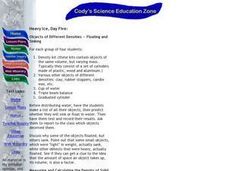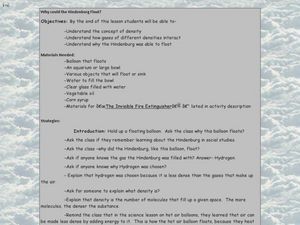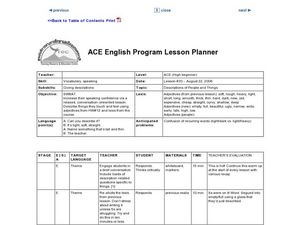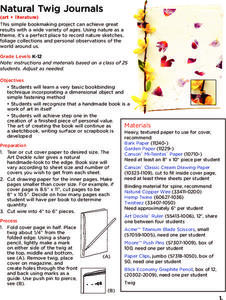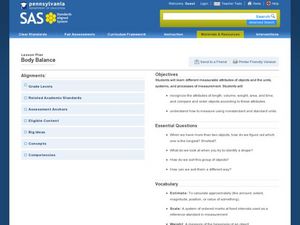Curated OER
Weight: Heavy or Light Worksheet
Which is heavier, a ladybug or a ship? Learners will have fun with this weight comparison worksheet, that uses visuals to help them determine which is heavier or lighter. They complete two comparisons for each. Lastly, they examine four...
Curated OER
Which is the Lighter Object?
In this weight comparison worksheet, students are given two sets of objects and click on the lighter object. This is an interactive worksheet with six sets of objects.
LABScI
Kinematics: The Gravity Lab
Falling objects can be brutal if you don't protect your noodle! Scholars explore the motion of falling objects through measuring short intervals to determine if the distance traveled varies with time. Building off of this, scholars...
Chymist
Build a Spectroscope
Assist your emerging scientists with construction of their very own spectroscopes. Individuals construct a spectroscope to identify elements used in varying lights within a particular environment. They conclude the activity with a...
Curated OER
Tic Tac KNOW: Heat and Light
This is a very developed interactive tic-tac-toe game, with 29 separate game slides. To place a mark on the grid, learners must answer a question correctly. When the grid place is selected the energy, heat and light questions...
Curated OER
Heavy or Light - tie and radio
In this heavier worksheet, students choose which item is heavier between 2 pictures. Students choose between a tie and a radio.
Curated OER
Heavy or Light - boy and pencil
In this heavier worksheet, students choose which item is heavier between the two pictures. Students choose between a boy and a pencil.
Curated OER
Friction 1
In this friction activity, students test heavy and light objects to see if the more friction of the heavier object makes it easy or harder for it to slide. Students also answer 5 questions.
Curated OER
Which One Is Heavier?
For this which one is heavier worksheet, students decide between pictures of two object and click on the one that is heavier, with immediate online feedback, for 52 pairs of objects.
Curated OER
Galileo's Gravity
In this gravity worksheet, students use a ping pong ball, golf ball, tissue, and more to test which falls faster a heavy or light object. Students also answer 5 questions.
Curated OER
Newton's 2nd Law
Fourth graders explore Newton's second law of motion, testing and identifying the characteristics of objects that makes them easier or harder to push. They identify what types of objects are the hardest to move, then test a variety of...
Curated OER
Reflection of Light
Young scholars experiment with reflections of two plane mirrors placed at a 90 degree angle to see what will be reflected.
Curated OER
Heavy Ice: Day Five
Learners explore physics by conducting a class experiment. In this density lesson plan, students examine a list of items and discuss whether they will sink or float and then determine their density. Learners examine the objects over five...
Curated OER
F = ma, Inertia, and Action-Reaction
Fourth graders apply concepts of Newton's Laws in scientific inquiries. Use this lesson to have your charges test and identify the characteristics of objects that make them easier or harder to push. After a teacher-led demonstration,...
Curated OER
Density
Second graders watch a demonstration and complete an experiment to determine how an objects' density allows it to float or sink. They work in small groups to assimilate the characteristics of items that float as opposed to simply...
Curated OER
Why Could the Hindenburg Float?
Tenth graders experiment with floating and sinking objects and heavy and light liquids, using correct terms, like density, to explain what happens. In this Hindenburg lesson, 10th graders watch a demonstration called the invisible...
Hawaiʻi State Department of Education
Push and Pull
I love mixing arts lessons with core content! Here, the class will discuss energy, motion, and force (push/pull) as they review dance vocabulary and movements. They preview vocabulary for force and dance. Then they pair-up to dance a...
Space Awareness
Model of a Black Hole
Even light cannot leave the force of a black hole! Learners use a model to explore the gravitational force of a black hole. An elastic bandage and heavy ball serve to create the hole, while marbles become the victims of its strong force.
Curated OER
Energy At Play
If you can find Tinker Toys™, then this may be a fun assignment for your physical science class. Using the construction set and a few other toys, they examine the forces involved when it they are being played with. For each, they...
Curated OER
Description of People and Things
Elementary schoolers use adjectives correctly in their speech. They demonstrate adjectives using familiar objects. (For example, they might show narrow by walking between two chairs placed closely together.) Then they play antonym Bingo...
Curated OER
Natural Twig Journals
Artists of all ages participate in a very basic bookbinding technique incorporating a dimensional object and simple fastening method. They create their own book to use as a sketchbook, writing surface or scrapbook. The results are...
Exploratorium
Falling Feather
Whether or not Galileo actually dropped balls from the Leaning Tower of Pisa, this demonstration will solidly demonstrate that objects are accelerated at the same rate, regardless of mass. You will, however, need a vacuum pump and a few...
Curated OER
Spot the difference
In this differences worksheet, students complete fill in the blanks and multiple choice questions about the differences in snowman pictures, and name the objects of pictures. Students complete 3 activities.
Curated OER
Body Balance
Examine measurable characteristics of objects to build an understanding of the different ways you can discuss an object's size when comparing it to other objects. After whole group instruction, the class compares and organizes several...












